Welcome to the fascinating world of the Ophiuchus constellation, where countless deep-sky objects await exploration. From star clusters to nebulae and galaxies, this celestial region offers a wealth of celestial marvels to discover. In this article, we will delve into the wonders of the Ophiuchus constellation, unveiling its secrets, mythology, and historical significance. We will then take a closer look at the various deep-sky objects within Ophiuchus, including star clusters, nebulae, and galaxies. Whether you are an avid astronomer or simply curious about the wonders of the universe, this article will guide you through the process of exploring the awe-inspiring deep-sky objects within the Ophiuchus constellation.
Contents
- The Ophiuchus Constellation
- Deep-Sky Objects in Ophiuchus
- 1.1 Overview of Ophiuchus
- 1.2 Mythology and History
- 2.1 Ophiuchus Star Clusters
- 2.2 Ophiuchus Nebulae
- 2.3 Ophiuchus Galaxies
- Exploring Ophiuchus’s Deep-Sky Objects
- Conclusion
-
Frequently Asked Questions
- 1. What is the significance of the Ophiuchus constellation?
- 2. How can I locate the Ophiuchus constellation in the night sky?
- 3. Are there any famous deep-sky objects within Ophiuchus?
- 4. What equipment do I need to observe deep-sky objects in Ophiuchus?
- 5. When is the best time to view the deep-sky objects in Ophiuchus?
- 6. Can I observe Ophiuchus from any location on Earth?
- 7. Are there any myths associated with Ophiuchus?
- 8. How far away are the deep-sky objects in Ophiuchus?
- 9. Can deep-sky objects in Ophiuchus be seen with the naked eye?
- 10. Are there any other interesting constellations near Ophiuchus?
- References
-
Frequently Asked Questions
- 1. What is the significance of the Ophiuchus constellation in astronomy?
- 2. How can I locate the Ophiuchus constellation in the night sky?
- 3. Are there any notable star clusters within the Ophiuchus constellation?
- 4. What are the most prominent nebulae found in the Ophiuchus constellation?
- 5. Can I observe galaxies within the Ophiuchus constellation using a telescope?
- 6. What equipment do I need to explore the deep-sky objects within Ophiuchus?
- 7. Any tips for observing deep-sky objects within the Ophiuchus constellation?
- 8. When is the best time to view the deep-sky objects within Ophiuchus?
- 9. Are there any cultural or historical references associated with the Ophiuchus constellation?
- 10. Can I photograph the deep-sky objects within the Ophiuchus constellation?
- References
- Read More
The Ophiuchus Constellation
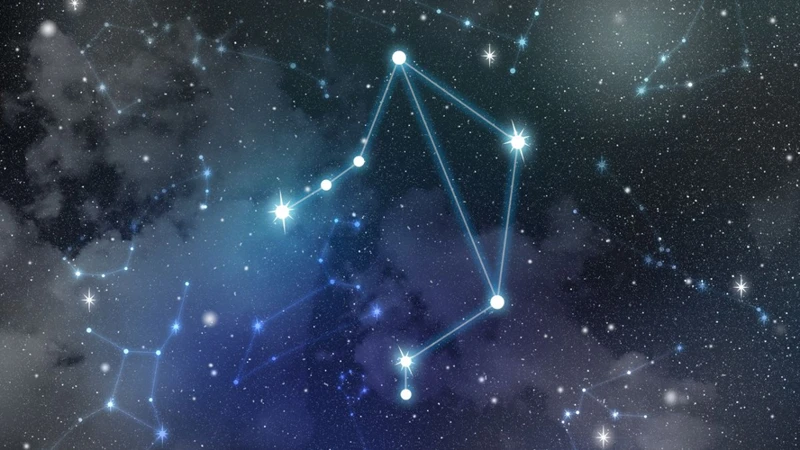
The Ophiuchus constellation, also known as the Serpent Bearer, is a fascinating region of the night sky that holds numerous celestial treasures. This constellation is home to a wide array of deep-sky objects, including star clusters, nebulae, and galaxies, making it a prime destination for stargazers and astronomers alike. Ophiuchus is positioned near the celestial equator, allowing it to be visible from various locations on Earth. According to mythology, Ophiuchus represents the Greek mythological figure Asclepius, the god of medicine and healing. In Japanese mythology, Ophiuchus is believed to symbolize the snake goddess, creating a link between different cultural interpretations of the constellation. Its rich history and diverse celestial population make the Ophiuchus constellation a captivating subject for exploration and study. So grab your telescope, prepare to embark on a celestial journey, and uncover the wonders hidden within the vast expanse of Ophiuchus.
1.1 Overview of Ophiuchus
Ophiuchus is a prominent constellation located near the celestial equator, making it visible from various parts of the world. With its name originating from the Greek word for “serpent bearer,” this constellation holds a special place in both mythology and astronomy. Ophiuchus encompasses a vast region of the night sky, stretching across 948 square degrees. It lies between the constellations of Hercules and Sagittarius, and it is bordered by Serpens Caput and Serpens Cauda. Ophiuchus is well-known for its position along the ecliptic, the path traced by the Sun, Moon, and planets. Although it is not officially considered one of the twelve zodiac constellations, it does fall along the path of the Sun’s apparent motion. Ophiuchus is also home to several noteworthy deep-sky objects, including star clusters, nebulae, and galaxies. Exploring this constellation can provide stargazers with a wealth of celestial wonders to observe and study. So, let’s delve deeper into the captivating world of Ophiuchus, uncovering its mysteries, mythology, and the incredible deep-sky objects that lie within its boundaries.
1.2 Mythology and History
The mythology and history surrounding the Ophiuchus constellation add depth and intrigue to its celestial presence. Known as the Serpent Bearer, Ophiuchus has its roots in Greek mythology, where it represents the figure of Asclepius, the god of medicine and healing. Asclepius was renowned for his ability to resurrect the dead, which ultimately led to his demise at the hands of Zeus, who feared his powers. In Japanese mythology, Ophiuchus takes on a different interpretation and is associated with the snake goddess. This diverse cultural significance highlights the universal fascination with serpents and their portrayal in various mythologies.
The historical significance of Ophiuchus extends beyond mythology and into ancient civilizations. The constellation’s position in the night sky made it visible to many cultures throughout history, leading to its inclusion in numerous ancient astronomical systems. In ancient Egypt, Ophiuchus was associated with the god Imhotep, who was believed to have healing powers and was considered the patron of physicians. This connection between Ophiuchus and healing is consistent across different cultures.
The Ophiuchus constellation’s mythology and history provide an intriguing backdrop to its astronomical exploration. Whether you are exploring its celestial wonders through a telescope or pondering the cultural significance it holds, delving into the mythology and history of Ophiuchus enhances our understanding and appreciation of this captivating constellation.
Japanese mythology adds an interesting perspective to the overall understanding of Ophiuchus.
Deep-Sky Objects in Ophiuchus
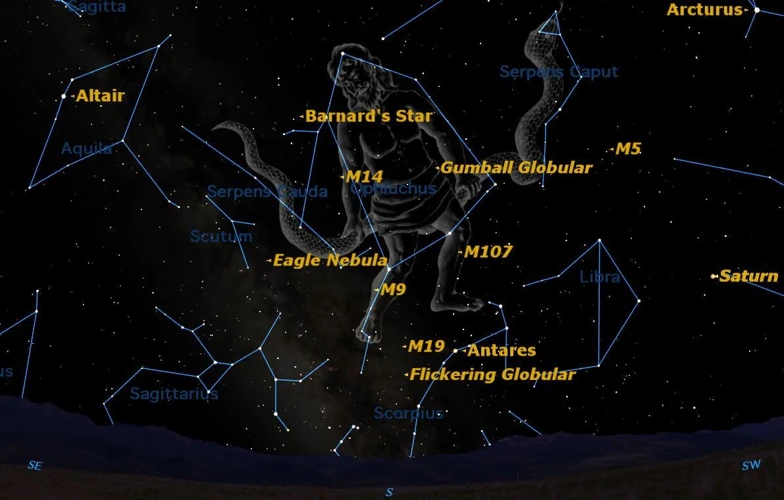
The Ophiuchus constellation is a treasure trove of deep-sky objects that offer breathtaking views of the cosmos. Among the many wonders found within Ophiuchus are its star clusters, nebulae, and galaxies, each offering a unique and awe-inspiring sight. Star clusters like NGC 6633, IC 4756, and Messier 10 dazzle with their glittering congregation of stars illuminating the night sky. The nebulae of Ophiuchus, such as the mesmerizing Pipe Nebula and the enigmatic Rho Ophiuchi Complex, showcase intricate interstellar clouds and stellar nurseries in which new stars are born. Ophiuchus is also home to galaxies like Messier 14, Messier 19, and the captivating Golden Eye Galaxy, each adding to the tapestry of deep-sky objects within this celestial realm. Whether you’re an amateur astronomer or a seasoned stargazer, the deep-sky objects in Ophiuchus offer a captivating journey through the wonders of the universe. So grab your telescope and explore the depths of Ophiuchus, where mysteries and splendors await.
2.1 Ophiuchus Star Clusters
The Ophiuchus constellation is home to several mesmerizing star clusters that capture the imagination of astronomers and stargazers alike. These star clusters are dense gatherings of stars that form intriguing patterns against the backdrop of the night sky. Here are three prominent Ophiuchus star clusters that are worth exploring:
1. NGC 6633: Located near the head of Ophiuchus, NGC 6633 is a cluster that consists of about 80 stars. Its estimated age is around 400 million years, making it relatively young compared to other star clusters. This cluster is visually striking, with its stars forming an attractive arrangement that is a sight to behold.
2. IC 4756: Positioned near the border of Ophiuchus and Serpens Cauda, IC 4756 is a lovely star cluster that showcases a wide range of stellar brightness. It contains approximately 100 stars, giving it a rich and vibrant appearance. IC 4756 is estimated to be around 1 billion years old and is characterized by its diverse mix of blue, white, and yellow stars.
3. Messier 10: Also known as M10, this globular star cluster is a true celestial marvel. It is located within the boundaries of Ophiuchus, and its spherical shape is composed of thousands of tightly packed stars. With an estimated age of 13 billion years, Messier 10 is one of the oldest star clusters in our galaxy. Through a telescope, the individual stars within the cluster can be resolved, creating a breathtaking view.
These Ophiuchus star clusters offer a unique opportunity to witness the marvels of stellar communities and gain insight into the formation and evolution of stars. Whether you are a seasoned astronomer or a curious enthusiast, venturing into the depths of Ophiuchus’s starry clusters is sure to leave you in awe of the splendor of the universe. So, grab your telescope and embark on an exploration of these captivating celestial wonders.
2.2 Ophiuchus Nebulae
The Ophiuchus constellation is renowned for its stunning nebulae, which provide a captivating sight for astronomers and stargazers alike. Here are three notable Ophiuchus Nebulae that are worth exploring:
1. The Pipe Nebula: The Pipe Nebula, also known as Barnard 59, is a dark nebula located near the star Alpha Ophiuchi. This elongated, dark cloud of interstellar dust obscures the light from stars behind it, creating a characteristic pipe-like shape. The Pipe Nebula is an excellent subject for astrophotography, showcasing intricate details and demonstrating the vastness of the cosmos.
2. Barnard’s Star: Named after the astronomer Edward Emerson Barnard, Barnard’s Star is a dim red dwarf located in Ophiuchus. While not a nebula itself, Barnard’s Star is notable for its proximity to several dark nebulae, making it an essential marker for navigating the Ophiuchus region. This star, which is relatively close to our solar system, plays a significant role in astronomical calculations and has been subject to various scientific studies.
3. Rho Ophiuchi Complex: The Rho Ophiuchi Complex is a visually stunning region located near the star Rho Ophiuchi. It includes a combination of colorful emission nebulae, reflection nebulae, and dark nebulosity, creating a celestial masterpiece. The Rho Ophiuchi Complex offers a wealth of intricate structures and is a popular target for astrophotographers.
These magnificent Ophiuchus Nebulae provide astronomers with invaluable insights into the formation and evolution of stars, as well as the interstellar medium. Their unique shapes, colors, and characteristics make them a captivating subject for both scientific study and artistic appreciation. Exploring the Ophiuchus Nebulae is an opportunity to witness the vast beauty and complexity of our universe. So, grab your telescope and immerse yourself in the mesmerizing world of these celestial wonders.
2.3 Ophiuchus Galaxies
2.3 Ophiuchus Galaxies
Within the vast reaches of the Ophiuchus constellation, a captivating assortment of galaxies await our exploration. These celestial marvels offer a glimpse into the grandeur and mystery of the universe. Let’s take a closer look at some of the notable galaxies within Ophiuchus:
Messier 14: Located approximately 30,000 light-years away from Earth, Messier 14 is a stunning globular cluster. With a diameter of around 100 light-years, this dense cluster is home to thousands of tightly packed stars. Its shimmering brilliance and intricate structure make it a sight to behold through a powerful telescope.
Messier 19: Situated roughly 28,000 light-years from Earth, Messier 19 is another remarkable globular cluster within Ophiuchus. This cluster boasts a particularly elongated shape, earning it the nickname “The Omega Cluster.” With an estimated age of around 11.7 billion years, it is one of the oldest known globular clusters in our galaxy.
Golden Eye Galaxy: Also known as NGC 4636, the Golden Eye Galaxy is a lenticular galaxy located about 62 million light-years away. Its name comes from its stunning golden glow when observed through a telescope. This galaxy is part of the Ophiuchus Cluster, a massive galaxy cluster that is rich in deep-sky objects.
Exploring these galaxies within Ophiuchus offers a glimpse into the diverse and awe-inspiring nature of our universe. They provide a fascinating insight into the evolution of galaxies and the vastness of cosmic space. So, grab your telescope and embark on a journey to witness the beauty and wonder of Ophiuchus’s galaxies.
Note: For more information about the influence of Jupiter in expanding horizons of luck, you can check out this link.
1.1 Overview of Ophiuchus
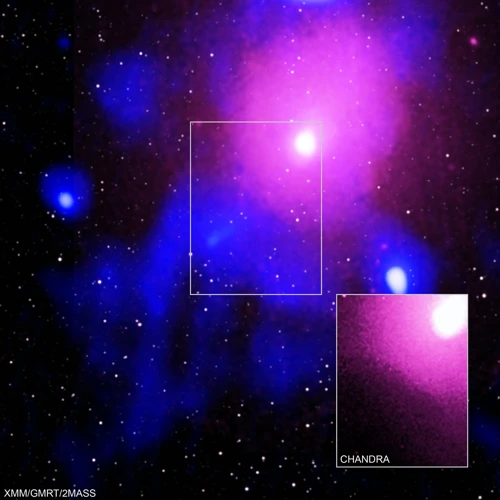
Located near the celestial equator, Ophiuchus is a mesmerizing constellation that spans across the night sky. With its name derived from Greek mythology, Ophiuchus represents the Serpent Bearer, symbolizing the mythological figure Asclepius, the god of medicine and healing. This constellation is home to a stunning collection of deep-sky objects, including star clusters, nebulae, and galaxies. Ophiuchus’ position allows it to be visible from many locations around the world, offering ample opportunities for stargazers and astronomers to explore its celestial wonders. Steeped in history and cultural significance, Ophiuchus has captivated the imaginations of people throughout the ages. So, grab your telescope and delve into the depths of Ophiuchus, uncovering the celestial splendors that have enthralled humans since ancient times.
1.1.1 Position and Features
Positioned at a celestial longitude of approximately 17 to 30 degrees, the Ophiuchus constellation can be found near the celestial equator, nestled between the constellations of Aquila, Sagittarius, and Scorpius. Its location in the Southern Hemisphere allows for excellent visibility from regions in the southern latitudes, although it can also be observed from northern latitudes during the summer months. Ophiuchus covers an area of about 948 square degrees, making it the 11th largest constellation in the night sky. It is characterized by its distinctive serpent-like shape, with the head of the serpent located near the star Rasalhague (Alpha Ophiuchi). This bright star serves as a useful guidepost for identifying the constellation. Ophiuchus is also home to numerous notable stars, including Cebalrai (Beta Ophiuchi), Sabik (Eta Ophiuchi), and Han (Zeta Ophiuchi). These stars contribute to the constellation’s overall brightness and captivating visual appeal. With its prominent position and notable features, Ophiuchus stands as a remarkable celestial entity, inviting skygazers to explore its deep-sky objects and unravel the mysteries of this ancient constellation.
1.1.2 Constellation Boundaries
The boundaries of the Ophiuchus constellation are defined by specific celestial coordinates determined by astronomers. Its right ascension spans from approximately 16 hours 0 minutes to 18 hours 40 minutes, while its declination extends from around -10 degrees to +6 degrees. These boundaries encompass a significant portion of the night sky, creating a space where Ophiuchus and its associated deep-sky objects can be observed and studied. Ophiuchus is surrounded by neighboring constellations, including Scorpius, Sagittarius, Serpens, Aquila, and Hercules, forming a celestial tapestry rich in astronomical wonders. By understanding and acknowledging the constellation’s boundaries, astronomers and stargazers can effectively explore and locate the deep-sky objects within Ophiuchus. So whether you’re admiring the star clusters, nebulae, or galaxies of this constellation, let its boundaries guide you in uncovering the celestial beauty that lies within.
1.2 Mythology and History
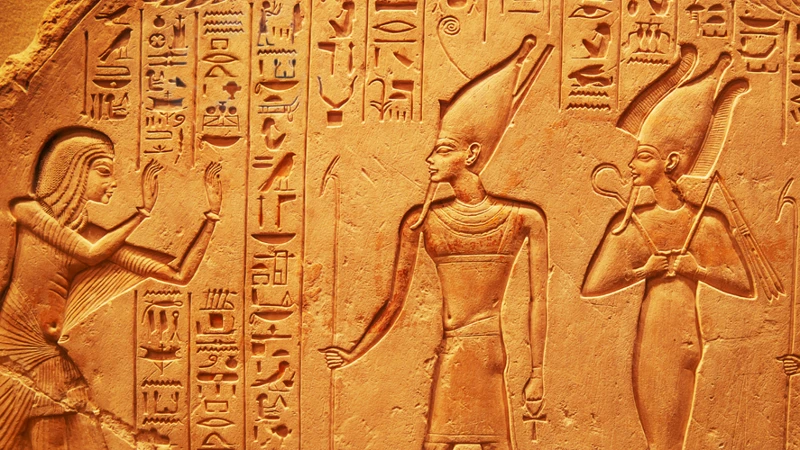
The mythology and history surrounding the Ophiuchus constellation add a layer of intrigue to its celestial presence. In Greek mythology, Ophiuchus is often associated with the figure of Asclepius, the god of medicine and healing. Legend has it that Asclepius learned the art of healing from the serpent, which is fitting given the association with the serpent in the constellation. In Japanese mythology, Ophiuchus holds a different significance, representing the snake goddess. These diverse mythologies highlight the cultural significance and interpretations of Ophiuchus throughout history. Beyond mythology, the Ophiuchus constellation also has historical connections. Its position in the sky has allowed it to be observed by ancient civilizations, including ancient Egypt, which had a thriving trade and commerce economy. This constellation has been observed and studied by astronomers for centuries, unveiling its cosmic wonders and contributing to our understanding of the universe. So as we explore the deep-sky objects within Ophiuchus, let us not forget the rich mythology and historical context that make this constellation all the more captivating.
1.2.1 The Serpent Bearer
In the realm of mythology and symbolism, the Ophiuchus constellation takes on the role of the Serpent Bearer. This title derives from Greek mythology, where Ophiuchus represents the figure of Asclepius, the god of medicine and healing. Asclepius was revered for his ability to restore health and bring comfort to those in need. The symbol associated with Ophiuchus is a staff with a serpent coiled around it, known as the Rod of Asclepius. This symbol is widely recognized as a representation of medicine and is often seen in modern healthcare settings. The serpent is an emblem of wisdom and healing, reflecting the celestial connection between Ophiuchus and the concept of healing. The Serpent Bearer is an enduring symbol that reminds us of the importance of caring for others and the healing power that exists within us. So, as we gaze upon the stars within the Ophiuchus constellation, we are reminded of the timeless significance of the Serpent Bearer and the tale it weaves across cultures and time.
1.2.2 Cultural Significance
The cultural significance of the Ophiuchus constellation is deeply rooted in various mythologies and belief systems across different cultures. In ancient Egyptian mythology, Ophiuchus was associated with Imhotep, an influential figure who served as a physician and architect. Imhotep was revered as a deity and was often depicted holding a staff with a serpent wrapped around it, symbolizing healing and wisdom. This connection between Ophiuchus and medicine is seen in other cultures as well. In Greek mythology, Ophiuchus represents Asclepius, the god of medicine and healing. Asclepius is often depicted holding a rod with a serpent coiled around it, known as the Rod of Asclepius, which has become a symbol of healing and medicine. The presence of Ophiuchus in ancient mythologies showcases the longstanding fascination and respect for the healing arts and the divine power associated with medicine. This cultural significance continues to influence and inspire modern interpretations of the Ophiuchus constellation, reinforcing its importance in our collective understanding of the cosmos.
2.1 Ophiuchus Star Clusters
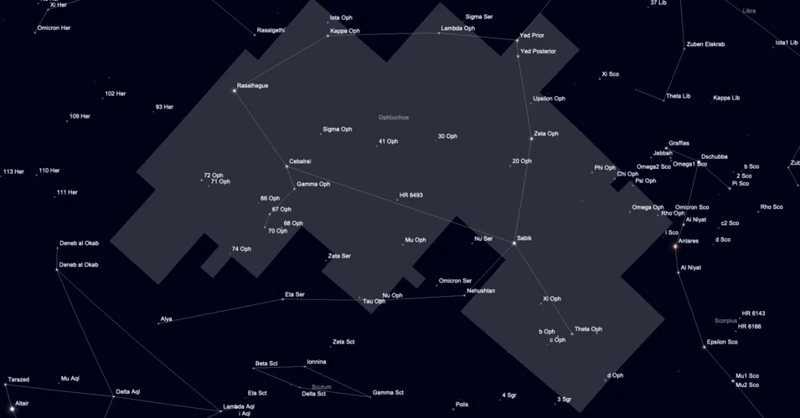
Within the Ophiuchus constellation, there are several captivating star clusters waiting to be explored. Star clusters are groups of stars that are gravitationally bound together, creating dazzling displays of stellar beauty. One notable star cluster within Ophiuchus is NGC 6633. This open star cluster is located near the border of the constellation and is easily visible with binoculars or a small telescope. Another fascinating star cluster is IC 4756, which is known for its distinctive shape resembling a diamond ring. Messier 10, a globular star cluster, is also found within Ophiuchus and features a dense concentration of stars. These star clusters provide opportunities for stargazers to observe the intricate patterns and formations created by these celestial objects./ancient-egypt-trade-commerce-economy/
2.1.1 NGC 6633
NGC 6633 is a fascinating star cluster located within the Ophiuchus constellation. It is a relatively young open cluster, estimated to be around 40 million years old. This cluster is composed of a group of stars that formed from the same molecular cloud, making them roughly the same age and sharing similar chemical compositions. NGC 6633 is known for its impressive number of stars, making it a spectacular sight when observed through a telescope. It consists of approximately 80 stars that are visible to the naked eye, and many more when viewed with binoculars or a telescope. This cluster has a distinct shape, resembling a tiny cloud of glittering stars against the backdrop of the night sky. NGC 6633 offers a beautiful visual experience, especially when viewed under dark and clear skies. Observing this cluster can be a delightful endeavor for both amateur and experienced astronomers, as it showcases the awe-inspiring diversity and grandeur of the universe.
2.1.2 IC 4756
IC 4756 is a mesmerizing star cluster that resides within the Ophiuchus constellation. Also known as the Serpent’s Basket Cluster, IC 4756 is a visual treat for astronomers and stargazers alike. This open cluster is located approximately 1,000 light-years away from Earth. With an estimated age of around 630 million years, IC 4756 is considered a relatively young cluster in astronomical terms. What makes IC 4756 truly remarkable is its unique shape and arrangement of stars. When observed through a telescope, the cluster appears like a delicate basket or bowl, where stars are densely packed together. Inside this celestial basket, you’ll find a spectacular blend of young and old stars, each contributing to the cluster’s overall radiance. IC 4756 offers a breathtaking sight for stargazers and serves as a testament to the beauty and diversity found within the Ophiuchus constellation. So, if you’re looking to explore a captivating open star cluster, don’t miss the opportunity to feast your eyes upon the stunning IC 4756 in the depths of Ophiuchus.
2.1.3 Messier 10
Messier 10, also known as NGC 6254 or the “The Wild Duck Cluster,” is a dazzling globular star cluster located within the boundaries of the Ophiuchus constellation. This remarkable cluster is estimated to be around 15,000 light-years away from Earth, and it spans approximately 83 light-years in diameter.
– Messier 10 was discovered by the French astronomer Charles Messier in 1764 and was later added to his famous Messier Catalog. It is named “The Wild Duck Cluster” due to its resemblance to a flock of ducks in flight.
– This globular cluster is comprised of several thousand stars held together by gravity. The cluster’s stars are predominantly old, with ages ranging from 9 to 12 billion years, making them some of the oldest known stars in the Milky Way galaxy.
– Messier 10 shines brightly, with an apparent magnitude of 6.6, making it visible to the naked eye under dark skies. However, observing this cluster through a telescope reveals its true beauty. The core of Messier 10 appears more densely packed with stars, while its outer regions become sparser, creating a stunning contrast.
– With a moderate-sized telescope, individual stars within Messier 10 can be resolved. The cluster exhibits a “salt and pepper” appearance, with brighter and dimmer stars scattered throughout, giving it a unique and captivating visual appeal.
– Messier 10 can be found in the northern part of Ophiuchus, southeast of the star Beta Ophiuchi. It is best observed during the months of May to August in the northern hemisphere.
Exploring Messier 10 provides a rewarding experience for astronomy enthusiasts, showcasing the intricate beauty of a globular star cluster and offering a glimpse into the ancient stellar populations of our galaxy. Whether observing it with a telescope or simply marveling at its celestial presence, Messier 10 is a captivating object within the Ophiuchus constellation that leaves a lasting impression.
2.2 Ophiuchus Nebulae
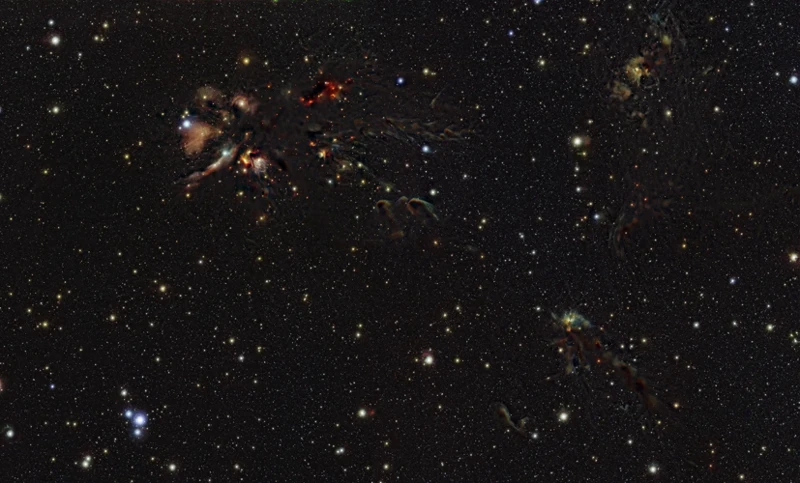
Ophiuchus Nebulae form a captivating part of the celestial landscape within the Ophiuchus constellation. These nebulae, which are vast clouds of gas and dust, provide a stunning visual spectacle for astronomers and stargazers. One notable nebula in Ophiuchus is the Pipe Nebula, a dark nebula known for its distinct elongated shape resembling a smoking pipe. Another intriguing nebula is Barnard’s Star, named after the renowned American astronomer Edward Emerson Barnard. This dim red dwarf star is surrounded by a dark nebula, creating an ethereal and enigmatic scene in the night sky. The Rho Ophiuchi Complex is also a prominent feature in Ophiuchus, composed of several reflection and emission nebulae. These nebulae, with their radiant colors and intricate structures, not only showcase the beauty of the cosmos but also shed light on the ongoing processes of star formation. Exploring these nebulae within Ophiuchus offers a glimpse into the fascinating interstellar dynamics that shape our universe.
2.2.1 The Pipe Nebula
The Pipe Nebula is one of the most intriguing deep-sky objects within the Ophiuchus constellation. It is a dark nebula, which means it consists of dense, obscuring dust that blocks the light from background stars. This enigmatic nebula stretches across approximately 15 degrees in the night sky, resembling a long, pipe-like shape, hence its name. Located near the bright star Alpha Ophiuchi, the Pipe Nebula offers a captivating sight for skywatchers. Its dark and shadowy appearance stands in stark contrast to the surrounding stars, creating a visually striking scene. The nebula is estimated to be around 600 light-years away from Earth and is believed to be a region where new stars may form in the future. The Pipe Nebula is a popular target for astrophotographers due to its unique shape and intriguing interplay of light and shadow. Capturing the essence of this dark beauty requires specialized equipment and techniques to properly capture its subtle details. The best time to observe the Pipe Nebula is during clear, moonless nights away from light pollution, allowing its delicate features to shine through. So, whether you are an amateur astronomer or a seasoned stargazing enthusiast, make sure to add the Pipe Nebula to your celestial bucket list for an awe-inspiring celestial experience.
2.2.2 Barnard’s Star
Known as one of the closest stars to our solar system, Barnard’s Star is a red dwarf located in the Ophiuchus constellation. Named after the American astronomer Edward Emerson Barnard, who discovered it in 1916, this star has captivated scientists and stargazers for decades. Barnard’s Star holds the distinction of having the largest known proper motion among all stars, meaning it appears to move across the sky at a rapid pace when observed over time. As a result, it has earned the nickname “the Runaway Star.”
With a magnitude of approximately +9.5, Barnard’s Star is not visible to the naked eye but can be easily spotted with a telescope or a pair of binoculars. It is located at a distance of approximately 5.96 light-years from Earth, making it the fourth-closest known individual star system to our solar system.
What makes Barnard’s Star particularly intriguing is the speculation surrounding the potential existence of exoplanets orbiting it. Various studies have been conducted to search for any planetary companions, but to date, no confirmed planets have been found. However, the possibility of Earth-sized planets in its habitable zone has fueled interest in further exploration and observation of this enigmatic star system.
The unique characteristics of Barnard’s Star have also sparked scientific debate and research, as astronomers continue to study its properties and use it as a benchmark for understanding stellar evolution. Its close proximity to us in astronomical terms makes it an important target for future space missions and the search for potential extraterrestrial life.
Barnard’s Star stands as a fascinating celestial object within the Ophiuchus constellation, renowned for its significant proper motion and potential exoplanetary system. As our understanding of this intriguing star continues to evolve, it opens up new avenues for unraveling the mysteries of the cosmos and expanding our knowledge of the universe.
2.2.3 Rho Ophiuchi Complex
The Rho Ophiuchi Complex is a captivating region within the Ophiuchus constellation that showcases a myriad of celestial wonders. It is a large and colorful nebula that is located near the bright star Antares in the neighboring Scorpius constellation. This complex is known for its stunning mix of interstellar dust clouds, gas clouds, and young stellar objects, which create a picturesque scene in the night sky.
The Rho Ophiuchi Complex is part of the larger Rho Ophiuchi cloud, which is one of the closest star-forming regions to Earth. It spans across approximately 14 light-years and is situated at a distance of about 460 light-years from our planet. This complex is composed of a variety of dark nebulae, including the prominent Snake Nebula (Barnard 72), which is shaped like a winding serpent slithering through space.
One of the highlights of the Rho Ophiuchi Complex is the presence of young stars surrounded by reflection nebulae. These stars are in the early stages of their formation and are still embedded in their birth clouds. The intense ultraviolet radiation emitted by these young stars causes the surrounding gas and dust to glow, resulting in the ethereal hues and intricate structures seen in the nebula.
The Rho Ophiuchi Complex also contains several notable objects, such as the globule IC 4592, commonly referred to as the Blue Horsehead Nebula due to its striking resemblance to the famous Horsehead Nebula in Orion. Another well-known feature is the Rho Ophiuchi Triple Star System, which consists of three stars that are gravitationally bound and orbiting each other.
Capturing the beauty of the Rho Ophiuchi Complex through astrophotography is a popular pursuit among amateur astronomers and professional photographers. The intricate details and vibrant colors of this region make it a visually stunning subject.
The Rho Ophiuchi Complex within the Ophiuchus constellation is a captivating celestial region that offers a visual feast of interstellar clouds, young stars, and stunning nebulae. Its intricate structures and vibrant colors make it a favorite target for both visual observation and astrophotography, providing a glimpse into the ongoing process of star formation and the beauty of our vast universe.
2.3 Ophiuchus Galaxies
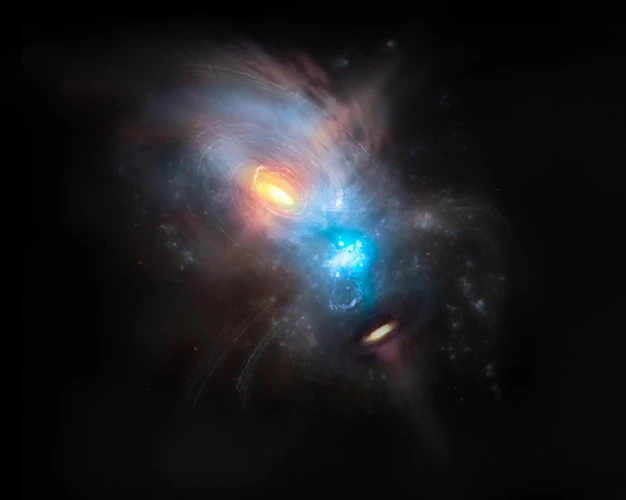
Within the Ophiuchus constellation, a marvelous display of galaxies awaits the curious observer. These celestial entities, with their vast distances and captivating formations, serve as windows into the vast expanse of the cosmos. Among the notable Ophiuchus galaxies is Messier 14, a beautiful globular cluster located approximately 30,000 light-years away. Its tightly packed stars create a stunning visual spectacle. Another prominent galaxy is Messier 19, a globular cluster known for its elongated shape and dense core. And let us not forget the Golden Eye Galaxy, a spiral galaxy adorned with bright arms and a central bulge, shimmering among the stars. Together, these galaxies, along with others within Ophiuchus, offer a glimpse into the intricate and mesmerizing nature of our universe, inviting us to explore and contemplate the wonders it holds.
2.3.1 Messier 14
One of the fascinating deep-sky objects within the Ophiuchus constellation is Messier 14. Also known as NGC 6402, Messier 14 is a globular cluster located approximately 30,000 light-years away from Earth. This cluster is estimated to be around 12 billion years old, making it one of the oldest known globular clusters in our galaxy. Messier 14 contains a myriad of stars densely packed together, creating a stunning visual spectacle. With a magnitude of 7.6, it is visible with binoculars, but a telescope is needed to truly appreciate its beauty. The core of Messier 14 is particularly dense, with stars tightly packed close to the center. Surrounding the core are layers of stars that gradually fade as they extend toward the outer reaches of the cluster. The stars within Messier 14 vary in color, ranging from bright blue to yellowish-orange, adding to the visual appeal of this celestial wonder. Exploring Messier 14 reveals a captivating tapestry of stars, showcasing the intricacies of our universe and captivating the imagination of astronomers and stargazers.
2.3.2 Messier 19
Messier 19 is an impressive globular cluster located within the boundaries of the Ophiuchus constellation. With a magnitude of 7.47, this cluster is easily visible through a medium-sized telescope. It is situated approximately 28,700 light-years away from Earth, making it one of the nearest globular clusters to our solar system.
This fascinating cluster boasts a dense central concentration of stars, creating a breathtaking visual spectacle. With an estimated age of around 12 billion years, Messier 19 is considered one of the oldest globular clusters in the Milky Way galaxy. It is believed to harbor hundreds of thousands of stars, each shining brightly against the backdrop of the cluster’s collective gravitational pull.
Messier 19 has a distinct elliptical shape, which sets it apart from other globular clusters. Its elongated structure adds to its uniqueness and visually distinguishes it from the spherical clusters commonly found in the night sky.
Observing Messier 19 provides an opportunity to witness the beauty and complexity of these stellar systems. Whether through the eyepiece of a telescope or astrophotography, capturing the intricate details of this globular cluster is a rewarding experience for amateur and professional astronomers alike.
To locate Messier 19 in the night sky, it is recommended to consult star charts or use astronomy apps that provide precise coordinates. It can usually be found in the southwestern part of Ophiuchus, not far from the constellation’s border with the neighboring constellation of Serpens.
So, as you explore the wonders of the Ophiuchus constellation, don’t forget to observe the magnificence of Messier 19. Its ancient age, unique shape, and stellar abundance make it a captivating deep-sky object that will leave you in awe of the vastness and beauty of our universe.
2.3.3 Golden Eye Galaxy
The Golden Eye Galaxy, also known as Messier 59, is a remarkable deep-sky object within the Ophiuchus constellation. It is a lenticular galaxy located approximately 60 million light-years away from Earth. Here are some key details about the Golden Eye Galaxy:
1. Classification: The Golden Eye Galaxy is classified as an lenticular galaxy (S0) due to its unique shape and composition. It falls somewhere between an elliptical and a spiral galaxy, characterized by a central bulge and a disc-like structure.
2. Features: This galaxy is known for its smooth and featureless appearance compared to other spiral galaxies. It lacks prominent arms and has a more rounded shape. Despite its seemingly uniform structure, close examination reveals the presence of faint dust lanes and stellar clusters.
3. Golden Eye Appearance: The Golden Eye Galaxy earned its name due to its golden-yellowish hue, which is attributed to the predominance of older, cooler stars within its stellar population. This distinctive coloration sets it apart from other galaxies within the same region.
4. Inhabitants: The Golden Eye Galaxy hosts various stellar populations, including globular clusters, which are densely packed groups of stars that orbit around the galaxy’s core. These clusters add to the galaxy’s intricate beauty and provide valuable insights into its formation and evolution.
5. Exploration Challenges: While the Golden Eye Galaxy is visible through telescopes, capturing its intricate details requires observing under optimal conditions. Dark skies, clear weather, and professional-grade telescopes are advantageous for observing this elusive deep-sky object.
6. Scientific Significance: The Golden Eye Galaxy’s unique morphology and characteristics provide astronomers with valuable information about the processes of galaxy evolution and the dynamics of galactic structures. Studying lenticular galaxies like the Golden Eye contributes to our understanding of the broader universe.
The Golden Eye Galaxy (Messier 59) is a visually distinctive lenticular galaxy located within the Ophiuchus constellation. Its smooth, round shape, golden-yellow appearance, and presence of stellar clusters make it an intriguing target for amateur and professional astronomers alike. By studying this galaxy, scientists gain insights into the fascinating formation and evolution of galaxies across the cosmos.
Exploring Ophiuchus’s Deep-Sky Objects
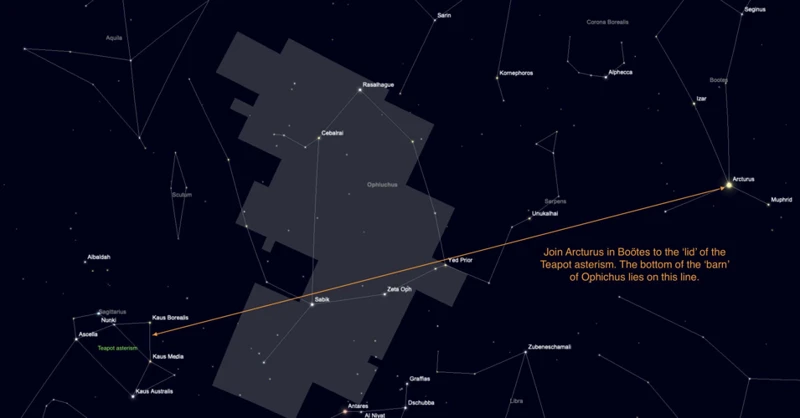
To embark on the journey of exploring Ophiuchus’s deep-sky objects, it is crucial to come prepared with the right equipment and knowledge. First and foremost, having a reliable telescope with a good aperture and magnification capabilities is essential for observing these celestial wonders. Additionally, a star chart or planetarium software can aid in identifying and locating specific objects within Ophiuchus. When observing deep-sky objects, it is advisable to find a dark viewing location away from light pollution, as this can greatly enhance the visibility and clarity of the objects. Patience and persistence are key when exploring Ophiuchus, as some objects may require long exposure times or multiple observation sessions to fully capture their beauty. Remember to take breaks and give your eyes a chance to adjust to the darkness, as this can enhance your ability to see faint objects. By following these tips and making the most of optimal viewing times, such as during new moon phases, you can embark on a fulfilling journey of exploring the mesmerizing deep-sky objects nestled within Ophiuchus. So, grab your telescope, immerse yourself in the wonders of the night sky, and let Ophiuchus unveil its celestial treasures.
3.1 Equipment Needed
To embark on an exploration of the deep-sky objects within the Ophiuchus constellation, you will need some essential equipment. Here is a list of the equipment needed to enhance your observing experience:
1. Telescope: A good quality telescope is crucial for observing the deep-sky objects in Ophiuchus. Look for a telescope with a moderate to large aperture size, as this will allow you to capture more light and see faint objects more clearly.
2. Mount: Consider investing in a sturdy mount or tripod to stabilize your telescope. This will help reduce any vibrations or shaking, allowing for more precise observations.
3. Eyepieces: A variety of eyepieces with different focal lengths is essential for adjusting the magnification of your telescope. Experiment with different eyepieces to find the best view of the deep-sky objects within Ophiuchus.
4. Filters: Filters can enhance your observations by reducing light pollution, enhancing contrast, or highlighting specific wavelengths of light. Consider using filters such as light pollution filters, nebula filters, or color filters to enhance your viewing experience.
5. Star Chart or Astronomy App: To navigate the sky and locate specific deep-sky objects within Ophiuchus, a star chart or an astronomy app on your smartphone can be immensely helpful. These tools will guide you to the coordinates and positions of the objects you want to observe.
Remember, investing in good quality equipment can greatly enhance your observing experience and allow you to fully appreciate the beauty of the deep-sky objects within the Ophiuchus constellation.
3.2 Observing Tips
Observing deep-sky objects within the Ophiuchus constellation can be a rewarding and exhilarating experience for both amateur and experienced astronomers. To make the most out of your observing session, here are some useful tips to keep in mind. Firstly, find a location away from light pollution, as it can hinder your ability to see faint objects. Look for a dark sky site or a remote area with minimal artificial lights. It is also important to be patient and allow your eyes to adapt to the darkness, as it can take up to 30 minutes for your eyes to reach their full night vision potential. Another important tip is to use the appropriate equipment for your observations. A telescope with a moderate to high aperture is recommended to capture the fine details of deep-sky objects. Additionally, consider using filters to enhance the visibility of certain features, such as nebulae. Preparing a star chart or utilizing astronomy apps can be helpful for locating specific deep-sky objects within the constellation. Finally, timing is crucial. Plan your observing session on a clear and moonless night for optimal viewing conditions. By following these observing tips, you can maximize your chances of spotting and appreciating the breathtaking deep-sky objects within the Ophiuchus constellation.
3.3 Best Time for Viewing
The best time for viewing the deep-sky objects within the Ophiuchus constellation largely depends on the specific object of interest. However, there are some general guidelines to keep in mind. Here are the best times for viewing different types of deep-sky objects in Ophiuchus:
1. Star Clusters: Star clusters in Ophiuchus, such as NGC 6633, IC 4756, and Messier 10, can be observed throughout the year. However, the best viewing conditions are during the spring and summer months. During these seasons, the constellation is high in the sky and the nights tend to be clear and free from light pollution.
2. Nebulae: Nebulae like the Pipe Nebula, Barnard’s Star, and the Rho Ophiuchi Complex are best observed during the summer months when the constellation is high in the sky. These objects often require darker skies and may benefit from the absence of moonlight, so checking the lunar phases before planning an observation is recommended.
3. Galaxies: Galaxies in Ophiuchus, such as Messier 14, Messier 19, and the Golden Eye Galaxy, are visible year-round. However, they may be more challenging to observe due to their dimmer nature. It is advisable to plan observations during moonless nights and seek out locations with minimal light pollution for the best possible views.
Remember, astronomy is a discipline that requires patience and perseverance. It is essential to check weather conditions, consult star charts or apps, and plan your observing sessions accordingly. By following these tips and taking advantage of optimal viewing times, you can enhance your experience and truly appreciate the hidden wonders within the Ophiuchus constellation.
Conclusion

In conclusion, the Ophiuchus constellation offers a fascinating glimpse into the wonders of the universe. From its rich mythology and historical significance to the myriad of deep-sky objects it harbors, Ophiuchus captivates both astronomers and stargazers. Exploring the deep-sky objects within Ophiuchus, such as star clusters, nebulae, and galaxies, provides an opportunity to witness the beauty and complexity of our universe. By equipping yourself with the necessary equipment and following some observing tips, you can embark on an unforgettable journey of discovery. The best time for viewing Ophiuchus and its deep-sky objects varies throughout the year, so it’s important to plan your observations accordingly. Whether you are a beginner or a seasoned astronomer, Ophiuchus offers an exciting and rewarding experience. So, venture into the night sky and let the wonders of the Ophiuchus constellation unfold before your eyes.
Frequently Asked Questions

1. What is the significance of the Ophiuchus constellation?
The Ophiuchus constellation holds cultural and mythological significance across different civilizations. It represents the Greek figure Asclepius, the god of medicine, and in Japanese mythology, it symbolizes the snake goddess. Its celestial objects also contribute to our understanding of the universe.
2. How can I locate the Ophiuchus constellation in the night sky?
Ophiuchus can be found in the southern sky, between the constellations of Scorpius and Sagittarius. Look for a distinct shape resembling a serpent bearer or a curved line of stars forming the outline of the constellation.
3. Are there any famous deep-sky objects within Ophiuchus?
Absolutely! Ophiuchus is home to several renowned deep-sky objects. These include the NGC 6633 and IC 4756 star clusters, the Pipe Nebula, and galaxies such as Messier 10 and the Golden Eye Galaxy.
4. What equipment do I need to observe deep-sky objects in Ophiuchus?
To observe deep-sky objects in Ophiuchus, a telescope is essential. A medium to large aperture telescope will allow you to see more detail and capture fainter objects. Additionally, using a star chart or planetarium software can help you navigate the night sky more effectively.
5. When is the best time to view the deep-sky objects in Ophiuchus?
The best time to view deep-sky objects in Ophiuchus is during the summer months in the Northern Hemisphere. During this time, Ophiuchus is more prominent in the night sky and is visible for longer durations.
6. Can I observe Ophiuchus from any location on Earth?
Yes, Ophiuchus can be observed from most locations on Earth. However, its visibility may vary depending on your latitude and the season. The closer you are to the equator, the higher Ophiuchus will be in the sky.
7. Are there any myths associated with Ophiuchus?
Yes, Ophiuchus is rich in mythology. In Greek mythology, it is associated with Asclepius, a healer who was thought to possess the power to resurrect the dead. The constellation’s representation varies across cultures, reflecting the diverse interpretations of this celestial region.
8. How far away are the deep-sky objects in Ophiuchus?
The distances of deep-sky objects in Ophiuchus can vary greatly. Star clusters like NGC 6633 and IC 4756 are relatively close, with distances of a few thousand light-years. Galaxies such as Messier 10 and the Golden Eye Galaxy are much farther, ranging from millions to billions of light-years away.
9. Can deep-sky objects in Ophiuchus be seen with the naked eye?
While some of the brighter and larger deep-sky objects in Ophiuchus may be visible to the naked eye under exceptional conditions, a telescope is typically required to observe the finer details and appreciate the full splendor of these celestial wonders.
10. Are there any other interesting constellations near Ophiuchus?
Absolutely! Ophiuchus shares its celestial neighborhood with neighboring constellations like Scorpius and Sagittarius, which are also packed with fascinating deep-sky objects. These constellations provide additional opportunities for stargazing and exploration.
References
Frequently Asked Questions

1. What is the significance of the Ophiuchus constellation in astronomy?
The Ophiuchus constellation holds great importance in astronomy due to its rich collection of deep-sky objects, including star clusters, nebulae, and galaxies, which provide valuable insights into the formation and evolution of the universe.
2. How can I locate the Ophiuchus constellation in the night sky?
To locate the Ophiuchus constellation, look for it near the celestial equator, between the constellations of Scorpius and Sagittarius. It is best observed during the summer months in the northern hemisphere.
3. Are there any notable star clusters within the Ophiuchus constellation?
Absolutely! The Ophiuchus constellation is home to several remarkable star clusters, such as NGC 6633, IC 4756, and Messier 10, each offering a dazzling display of stars at different stages of their lifecycle.
4. What are the most prominent nebulae found in the Ophiuchus constellation?
The Ophiuchus constellation boasts a variety of nebulae, including the famous Pipe Nebula, Barnard’s Star, and the stunning Rho Ophiuchi Complex. These nebulae showcase the beauty of interstellar dust and gas clouds.
5. Can I observe galaxies within the Ophiuchus constellation using a telescope?
Absolutely! The Ophiuchus constellation is home to several galaxies worth observing, such as Messier 14, Messier 19, and the captivating Golden Eye Galaxy (NGC 6543). These galaxies offer a glimpse into the vastness of our universe.
6. What equipment do I need to explore the deep-sky objects within Ophiuchus?
To explore the deep-sky objects within Ophiuchus, you will need a reliable telescope with decent magnification capabilities, along with a star chart or smartphone app to help you navigate the night sky.
7. Any tips for observing deep-sky objects within the Ophiuchus constellation?
Be sure to find a dark and clear observing location away from light pollution. Allow your eyes to adjust to the darkness, and take your time to observe each object carefully. Additionally, try using different eyepieces to vary the magnification.
8. When is the best time to view the deep-sky objects within Ophiuchus?
The best time to view the deep-sky objects within Ophiuchus is during the summer months in the northern hemisphere. Clear nights away from the full moon will provide optimal visibility and allow for a better observing experience.
9. Are there any cultural or historical references associated with the Ophiuchus constellation?
Yes, the Ophiuchus constellation has deep roots in mythology and history. It is often associated with the myth of Asclepius, the Greek god of medicine, and represents the serpent bearer. Various cultures have interpreted this constellation differently throughout history.
10. Can I photograph the deep-sky objects within the Ophiuchus constellation?
Absolutely! With the right equipment and techniques, it is possible to capture stunning photographs of the deep-sky objects within the Ophiuchus constellation. Astrophotography offers a unique way to document and share the beauty of these celestial wonders.







